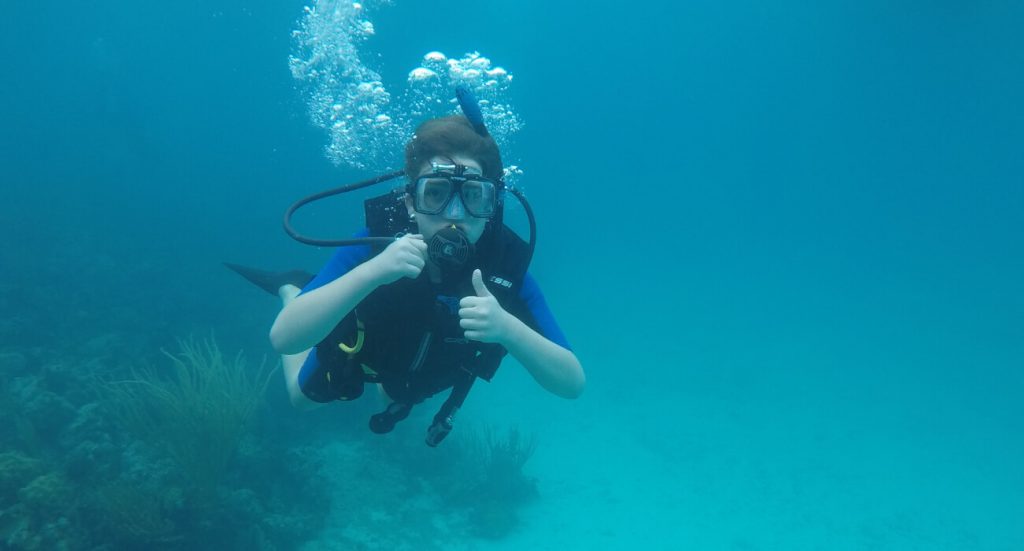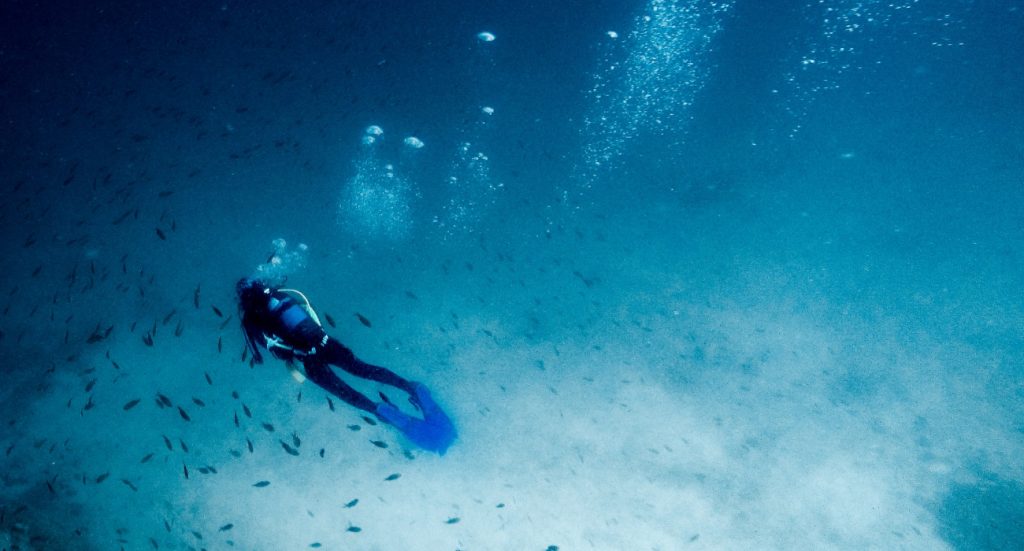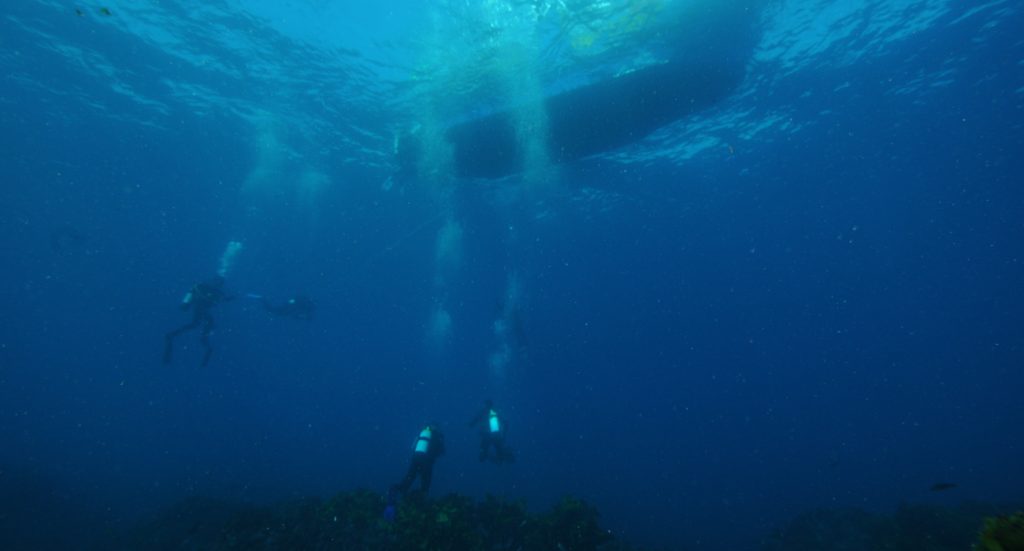Compared to many other outdoor activities, scuba diving is generally considered a low-risk activity. However, it does involve some inherent dangers for which it requires training and good health. Being aware of the main scuba diving risks is the first in many steps you have to take to prevent harm and practice safe diving.
1. Decompression Sickness
Developing decompression sickness (DCS), or the bends, is one of the most common scuba diving health risks. The term is used to describe an illness that results from a rapid decrease in the pressure surrounding you. It occurs mostly in scuba diving and deep-sea diving because when you dive with compressed air, your body takes in extra oxygen and nitrogen. While your body uses the oxygen, the nitrogen gets dissolved into the blood and remains there during the dive.
As you ascend towards the surface of the water, the water pressure around you decreases. In rapid ascents, the nitrogen does not have time to clear out and forms bubbles in your tissues and bloodstream. These microbubbles can cause damage to your blood vessels and block normal blood flow. Symptoms include joint and muscle pain, loss of hearing, nausea, memory loss, confusion, and uncontrollable shaking, among others.
Although DCS hits randomly, there are a few factors that may put you at higher risk of developing this illness: heart muscle birth defects, low cardiovascular fitness, use of alcohol or tobacco, a high percentage of body fat, old or current injuries, lung disease, diving in cold water, and fatigue. Females and people over the age of 30 are also more at risk, according to Harvard Health Publishing.
There are different levels of DCS, and the symptoms can appear as late as 48 hours after the dive. Some cases can be very serious, even life-threatening. Take the necessary prevention measures before and after each dive and discuss your concerns with your doctor, especially if you suffer from a medical disease or condition.
2. Nitrogen Narcosis
Nitrogen narcosis, or inert gas narcosis/ rapture of the deep/Martini effect, is a temporary condition that affects deep-sea divers that swim past 100 feet (30 meters). The condition is caused by breathing nitrogen at a high partial
pressure.
The partial pressures of oxygen and nitrogen at sea level are around 0.21 atm and 0.78 atm, respectively. Upon descend, the partial pressure of the gases increases. When a diver reaches a depth of about 131 feet (40 meters), the partial pressures of oxygen and nitrogen are about 1.05 atm and 3.9 atm, respectively.
When you inhale the gases at a higher partial pressure, you experience symptoms similar to those of drunkenness. It’s one of the reasons why deep divers require additional training to combat these issues.
Deep-sea divers can also use heliox (a mixture of helium and oxygen) instead, as it has been found that helium does not cause inert gas narcosis .
The symptoms of nitrogen narcosis include a sense of euphoria, disorientation, poor judgment, difficulty concentrating, hallucinations, and others. The condition usually resolves upon ascent, but it may – in some cases – increase the risk of developing other conditions such as DCS. It’s important to learn more about nitrogen narcosis so you can recognize it in yourself and others.
3. Barotrauma
Barotrauma is also among the common health risks scuba diving, and it is caused by the increased underwater pressure. There are different types of barotrauma, including sinus, teeth, and lung barotrauma, but the most common kind experienced by divers is middle-ear (otic) barotrauma. It can cause extreme pain, fluid buildup, bleeding, and even hearing loss.
Middle-ear barotrauma is often experienced by divers who fail to equalize the middle-ear pressure during descent. However, equalization is easily done by using various maneuvers such as swallowing or pinching the nose and blowing. If you cannot, for whatever reason, equalize, it’s best to end the dive.
4. Oxygen Toxicity
Although not among the most common scuba diving risks, oxygen toxicity is a medical condition that can have serious negative effects on the body. Open-circuit, rebreather, and Enriched Air Nitrox (EAN) divers who use mixed gases are exposed to the risk of oxygen toxicity. For most divers, this condition is not an issue, but at extreme depths too much oxygen becomes toxic.
The two types of oxygen toxicity are Central Nervous System Oxygen Toxicity (CNS), and Pulmonary Oxygen Toxicity (POT), the former being more common among divers. When diving extreme depth, it’s important to know what to look for in both yourself and others. Symptoms include convulsions, visual disturbances, nausea, twitching, dizziness, and irritability.
There’s no guarantee oxygen toxicity won’t affect deep divers even with preventive measures, but there are a few things you can do to minimize the risk. Do not exceed your depth limit, use a dive computer for tracking, analyze your gas every time, avoid exhaustion when underwater, and make sure you breathe easily.
5. Air or Gas Embolism
When you ascend too quickly, nitrogen bubbles can form in your tissue and blood. As discussed above, this is called decompression sickness. If those bubbles block a small artery, they can cut off some of the blood supply. Holding your breath can also cause the air in your lungs to expand, which may lead to lung tissue ruptures and arterial gas embolism due to the nitrogen bubbles being released into the arterial circulation.
The symptoms include joint and muscle pain, irregular heartbeat, chest pain, blurred vision, and anxiety, among others. Treatment involves hyperbaric oxygen therapy. Air or gas embolism is among the preventable scuba diving risks; limiting the depth of your dive, making a slow ascent, breathing normally, and not diving with a cold are among the many prevention measures you can take.
6. Running Out of Breathing Gas
Running out of breathing gas is a common scuba diving risk, especially among divers that lack training or inexperienced divers, as it often occurs due to poor gas management. It may also happen because of equipment failure and unforeseen exertion.
You must understand how much breathing gas you need for a particular dive, know how to calculate the limits of available gas, monitor the remaining gas, and ascend to the surface with enough breathing gas in your tank.
Air is the most common breathing gas used in scuba diving. If you’re not a commercial diver, tech diver or practicing other forms of advanced diving, chances are you’ll be diving on air supply. In this case, it’s advised to ascend with about 50 Bar (500 PSI) of breathing gas remaining in your tank.
7. Hypothermia
When diving in cold water, hypothermia is one of the common diving risks. Nonetheless, it can occur even in warm tropical waters because the water you dive in is almost always colder than the temperature of your body. Furthermore, water draws heat away from our bodies about 20 times faster than air, so it’s possible to develop mild hypothermia in most waters. It’s important to know the signs of hypothermia and ascend before it settles in.
Preventing hypothermia requires preparation; divers need to understand what type of protective garments they need for each specific dive and how to properly use it in order to conserve their body heat. Be prepared by undergoing training so you can be ready to act in case of a rescue/self-rescue.
8. Unsafe Marine Life Encounters
As you dive into the water, you’re entering untamed wilderness which you may know little about. Most creatures are not harmful or aggressive, but some may react in unpredictable ways if they feel threatened. Remember, it’s their home – not yours – you’re entering. Every diver should know not to touch or get too close to wildlife; it’s part of the diver etiquette.
Staying within a safe distance from both underwater fauna and flora not only ensures you’re not hurting them but also keeps you safe from any possible harm. Some animals bite while others secrete poison; even corals can cause stings and lacerations. Pay attention to your surroundings at all times and treat marine life with respect to avoid these scuba diving risks.
9. Malfunctioning Equipment
Defective equipment is yet another scuba diving risk. Some of the common equipment failures involve O-ring failure, rupture of a regulator hose, closing and jamming of the cylinder valve.
Always check the equipment for design flaws, tears, and functional issues before each dive. If you suspect your equipment may not be functioning correctly, ask for a new one. If you own your equipment, use it properly and perform maintenance.
10. Entrapment and Entanglement
According to Divers Alert Network, entrapment and entanglement are triggers in approximately 20 percent of fatal dive accidents. They are common factors in fatalities involving asphyxia. When you’re diving in an overhead environment with no direct, vertical access to the surface, all scuba diving risks are inherently higher.
Divers who wish to dive caves, caverns, wrecks or swim under ice should go through appropriate training. You’ll need to learn how to thoroughly plan your dive, use special equipment, and never dive alone. Entrapment can be prevented only by avoiding overhead environments – at least until properly trained, while fatal entanglement can be prevented by carrying a dive knife.
11. Getting Lost/Separated from the Group
Getting lost at sea or separated from your buddies can be a scary feeling. It may occur because you or your buddy wandered off in search of some interesting creature or were left behind by your dive boat (less likely, but it’s been known to happen). In case of emergency, the boat may need to leave quickly and leave behind some of the other divers.
The captain of the boat should brief divers on what to do if they don’t find the boat when they surface. If you’re not briefed on the matter, as it may sometimes happen, you should ask about the plan of action yourself.
Another boat should already be on its way to retrieve the stranded divers. Discuss the procedures for unlikely events with the captain, dive guide or instructor, and carry safety and signaling devices to be prepared for anything.
Always remain near the group, never dive alone even if you are an experienced diver, and go over the different scenarios that may occur with the boat crew and your buddies. It’s good to have a plan of action so you know what to do in case you ever get separated or left behind.
12. Drowning
The most common cause of diving fatalities is drowning, and this is because the victim dies in the water. Drowning while diving generally occurs due to some of the other risks described above or a medical condition. In fact, the cause of many drowning fatalities has been found to be a heart attack, generally triggered by a pre-existing pathology in the diver.
Equipment malfunction, gas-supply problems, and rough water are also triggers that can lead to drowning incidents. Proper training and a good buddy system can go a long way in preventing drowning. Regular checkups with your doctor should help you treat and manage many of the conditions that can cause incapacitation.
13. Overpowering Currents
Currents can be some of the most physically demanding and unpredictable obstacles a scuba diver can encounter during a dive. Strong currents can cause rapid air depletion, accelerated gas loading, exhaustion, and separation, among others. They can even prevent you from returning to the boat.
Those diving in strong currents, especially drift divers, need to have a good understanding of how currents work. Surface currents do not necessarily travel in the same direction as bottom currents, for example. Some can also reverse direction during a dive. Make sure you’re properly trained to dive difficult sites and have a plan in place.
14. Salt Water Aspiration
Another risk of scuba diving is salt water aspiration, a rare disorder suffered by those who inhale a mist of seawater. This is due to faulty equipment or poor diving technique but may also occur in near-drownings. Diagnosing sea water aspiration may prove difficult because the symptoms mimic those of decompression sickness and near-drowning.
Sea water aspiration has damaging effects on the diver’s lungs. Inhaling salt water can cause bodily fluids to move from your lungs to your breathing spaces, making breathing difficult or impossible. Most divers have mild reactions to salt water and resolve within a few hours. Some divers, however, have severe reactions and should seek immediate help if they suspect they may suffer from salt water aspiration.
15. Displacing the Second Stage
Although unlikely, having your second stage regulator displaced from your mouth can happen. This usually occurs when another diver accidentally pulls it from your mouth, gets entangled in kelp, gets knocked out by impact, you lose consciousness and release grip or when you displace it with your own arm movement.
Regulator recovery is a skill taught in diving school, so as long as you don’t panic you should be able to easily recover your second stage. Your diving buddy can help too, so make sure to signal them. In the meantime, it’s important to exhale continuously and not hold your breath.
16. Caustic Cocktail
One of the scuba diving risks affecting rebreathers is exposure to a caustic cocktail. This happens when the absorbent material used to remove carbon dioxide from the breathing gas is inundated with water. The contaminated water can move along the breathing loop and into the diver’s mouth. The caustic cocktail can cause choking and even caustic corrosion of the mucous membranes.
It’s important to always check your rebreather for leaks before each dive and close the surface valve when it’s not in your mouth. If the caustic cocktail enters your mouth, rinse your mouth and switch to an alternative gas supply before returning to the surface.
17. Being Hit by a Boat
Boat-propeller strikes cause hundreds of injuries and dozens of deaths in people engaging in water activities in the U.S. alone. The risk of accidents is higher for popular destinations that often have multiple boatloads of divers at the same dive site. Even the propeller of a small boat can cause a serious, even fatal injury.
Preventing accidents, especially in areas with a lot of boat traffic, requires divers and boaters to be constantly aware of their surroundings before making the ascent. Accidents can be avoided as long as both parties follow a set of key rules and have an emergency action plan set up.
18. Dysbaric Osteonecrosis
Dysbaric osteonecrosis (DON) is an avascular bone necrosis developed by those exposed to changes in pressure. More common among professional divers than recreational ones, it mostly affects compressed-air workers. For divers, the prevalence is higher for divemasters than others.
This bone necrosis is often associated with decompression sickness, although a clear correlation between the two has yet to be established. It is likelier that there are predisposing factors more dependent on variables related to high pressure that contribute to the development of DON.
Technical divers and those that regularly dive deeper than 100 feet (30 meters) are recommended to do a long bone survey every few years. This is also the case for those who regularly perform inadequate decompression.
Have you ever found yourself in a dangerous situation while diving? Leave us a comment below and tell us about the scuba diving risks you faced and how you overcame them.




Hayato Davis says:
Hey Bubbles! Yes, you are right, “Compared to many other outdoor activities, scuba diving is generally considered a low-risk activity.” Scuba diving involves some inherent dangers for which it requires training and good health. Thank you for letting us know about these dangerous risks that could happen during diving. Keep posting!
John Moore says:
I’m a PADI OWI for almost 20 years and dived for 20 years before that. The one rule that I follow is to stop the dive when I reach 500 psi. This is a minimum. You can never predict when you’ll need the extra air on the way back to the boat.
Danielcloub says:
This is a good post. This site is loaded with lots of interesting things, it helped me in many ways.
Petar Denoble says:
John, your text about DCS and AGE is relatively imprecise and, in some details, wrong. It would help if you asked a diving medicine specialist to review before posting such articles.